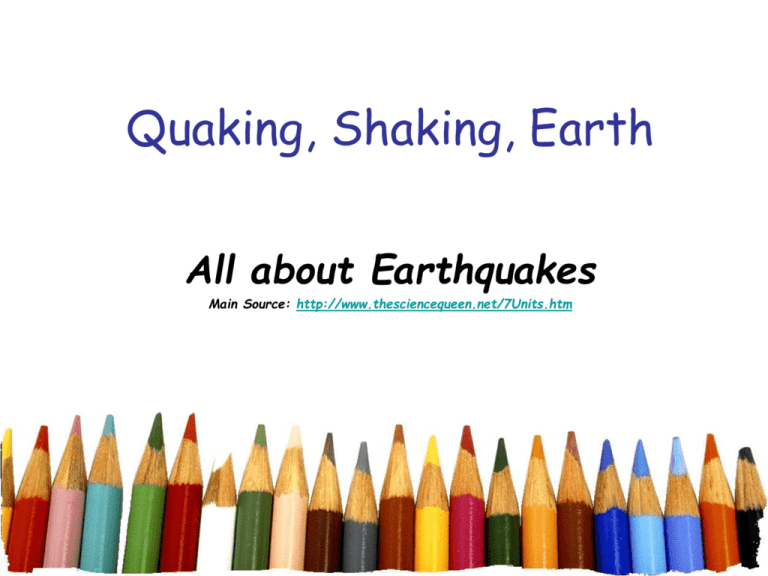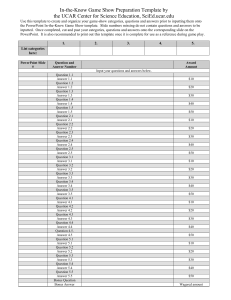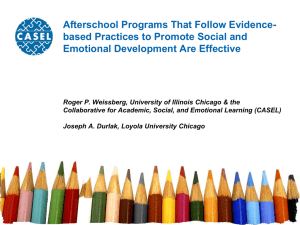Quaking, Shaking, Earth
advertisement

Quaking, Shaking, Earth All about Earthquakes Main Source: http://www.thesciencequeen.net/7Units.htm What is an earthquake? • Simply put: – An earthquake is the shaking of the earth. Free powerpoint template: www.brainybetty.com 2 Many buildings in Charleston, South Carolina, were damaged or destroyed by the large earthquake that occurred August 31, 1886. Picture from the United States Geological Service www.usgs.gov Free powerpoint template: www.brainybetty.com 3 San Francisco, California, Earthquake April 18, 1906. East side of Howard Street near Seventeenth Street. All houses shifted toward the left. The tall house dropped from its south foundation wall and leaned against its neighbor. 1906. Picture from USGS.GOV Free powerpoint template: www.brainybetty.com 4 San Fernando, California, Earthquake February 1971. Collapsed overpass connecting Foothill Boulevard and the Golden State Freeway. Feb 10, 1971. Photo by R.E. Wallace, USGS. www.usgs.gov Free powerpoint template: www.brainybetty.com 5 What causes an earthquake? An aerial view of the San Andreas fault in the Carrizo Plain, Central California. Picture from www.usgs.gov • Earthquakes are the Earth's natural means of releasing stress. • Due to the constant motion of the Earth’ plates, this put stress on the edges of the plates. • To relieve this stress, the rocks tend to bend, compress, or stretch. Free powerpoint template: www.brainybetty.com 6 Locatin' the Shakin' • Focus: the place on the Earth’s crust where the pressure was released. • Epicenter: the spot on the Earth’s surface directly above the focus. http://geomaps.wr.usgs.gov/parks/deform/ Free powerpoint template: www.brainybetty.com 7 Faults • If the force is great enough, the rocks will break. • An earthquake is the vibrations produced by the breaking of rock. The Hanshin expressway in Kobe, Japan collapsed due to an earthquake in 1995. • Most earthquakes occur near plate boundaries. Picture from http://www.ce.washington.edu/~liquefaction/html/quakes/kobe/kobe.html Free powerpoint template: www.brainybetty.com 8 Normal Fault • Drops rock on one side of the fault down relative to the other side. http://earthquake.usgs.gov/regional/imw/im ages/figure1.php Free powerpoint template: www.brainybetty.com 9 Wasatch Fault - Utah Free powerpoint template: www.brainybetty.com 10 Reverse Fault • Reverse faults result from compression forces that squeeze rock. • If rock breaks from forces pushing from opposite directions, rock above a reverse fault surface is forced up and over the rock below the fault surface. Free powerpoint template: www.brainybetty.com 11 Near Klamath Falls, Oregon http://pages.uoregon.edu/millerm/KlamT.jpeg Free powerpoint template: www.brainybetty.com 12 Strike-slip Fault • At a strike-slip fault, rocks on either side of the fault are moving past each other without much upward or downward movement. • The San Andreas Fault is the boundary between two of Earth’s plates that are moving sideways past each other. Free powerpoint template: www.brainybetty.com 13 San Andreas Fault, California The Pacific Plate lies to the west of the San Andreas Fault and the North American Plate lies to the east. Scientists have determined that the Pacific Plate moves northwest at the rate of about two inches every year relative to the North American Plate. The western half of California lies on the Pacific Plate while the eastern half of https://encryptedCalifornia lies on the North American Plate. tbn1.gstatic.com/images?q=tbn:ANd9GcTtVYa8xuT5pBjFVLP_sYSa_GrFZqFQO9LT EaDht6N3CUvjP7hZA Besides the short term effects of being an earthquake ‘hot zone’, western California will, in about one million years, be part of Alaska (assuming Alaska stays put), as the Pacific Plate continues its northwesterly trek. http://www.platetectonics.com/book/page_15.asp https://encryptedtbn3.gstatic.com/images?q=tbn:ANd9GcTyQlHA1d9NDVUSO_qxad6t2yJ3LanXsVzZF0tfUArgN Q-9j0-U Free powerpoint template: www.brainybetty.com 14 How does energy created by an earthquake move through the Earth? • Seismic waves are energy waves that travel outward from the source of the earthquake. Free powerpoint template: www.brainybetty.com 15 Surfin the Waves • When earthquakes occur, three different types of seismic waves are produced. Free powerpoint template: www.brainybetty.com 16 P Waves • Primary waves (Pwaves) cause particles in rocks to move back and forth in the same direction that the wave is traveling. • P-Waves are the fastest waves and are felt first, usually as a bang or a thump. Free powerpoint template: www.brainybetty.com 17 S Waves • Secondary waves (Swaves) move through Earth by causing particles in rocks to move at right angles to the direction of wave travel. • These waves are slower than P-Waves. Free powerpoint template: www.brainybetty.com 18 L Waves • Surface waves cause most of the destruction resulting from earthquakes. • Surface waves (LWaves) or land waves move rock particles in a backward, rolling motion and a side-to-side, swaying motion. Free powerpoint template: www.brainybetty.com 19 How are seismic waves measured? • Seismic waves from earthquakes are measured with an instrument known as a seismograph. • Seismographs register the waves and record the time that each arrived. Free powerpoint template: www.brainybetty.com 20 Measuring Earthquake Magnitude • Magnitude is a measure of the energy that is released during an earthquake. Free powerpoint template: www.brainybetty.com 21 Richter Scale • The Richter magnitude scale is used to describe the strength of an earthquake and is based on the height of the lines on the seismogram. Free powerpoint template: www.brainybetty.com 22 Richter Scale • For each increase of 1.0 on the Richter scale, the height of the line on a seismogram is ten times greater. • However, about 32 times as much energy is released for every increase of 1.0 on the scale. Free powerpoint template: www.brainybetty.com 23 Earthquake Severity • Richter Earthquake Magnitudes Effects • Less than 3.5 Generally not felt, but recorded. • 3.5-5.4 Often felt, but rarely causes damage. • Under 6.0 At most slight damage to well-designed buildings. Can cause major damage to poorly constructed buildings over small regions. • 6.1-6.9 Can be destructive in areas up to about 100 kilometers across where people live. • 7.0-7.9 Major earthquake. Can cause serious damage over larger areas. • 8 or greater Great earthquake. Can cause serious damage in areas several hundred kilometers across. Free powerpoint template: www.brainybetty.com 24 Magnitude vs. Ground Motion and Energy Magnitude Change Ground Motion Change (Displacement) Energy Change 1.0 10.0 times about 32 times 0.5 3.2 times about 5.5 times 0.3 2.0 times about 3 times 0.1 1.3 times about 1.4 times This table shows that a magnitude 7.2 earthquake produces 10 times more ground motion than a magnitude 6.2 earthquake, but it releases about 32 times more energy. The energy release best indicates the destructive power of an earthquake. http://earthquake.usgs.gov/earthquakes/eqarchives/year/eqstats.php Free powerpoint template: www.brainybetty.com 25 Frequency of Earthquakes Magnitude Average Annually 8 and higher 1¹ 7 - 7.9 15 ¹ 6 - 6.9 134 ² 5 - 5.9 1319 ² 4 - 4.9 13,000 (estimated) 3 - 3.9 130,000 (estimated) 2 - 2.9 1,300,000 (estimated) ¹ Based on observations since 1900. These numbers have been recently updated, based on data from the Centennial catalog (from 1900 to 1999) and the PDE (since 2000). ² Based on observations since 1990. http://earthquake.usgs.gov/earthquakes/eqarchives/year/eqstats.php Free powerpoint template: www.brainybetty.com 26 Recent Large Magnitude Earthquakes Top 10 Lists Free powerpoint template: www.brainybetty.com 27






